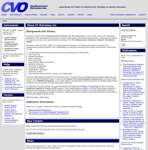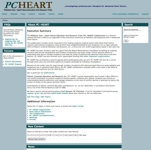Large-scale clinical research projects nearly always need to recruit patients and investigators from multiple sites, each of which is usually busy with other projects at the same time. Keeping all participants in such studies informed, up-to-date, and coordinated is a daunting challenge — one that is nearly impossible when the only communication tool is email.
Two such consortia for which The Epimetrics Group has produced collaborative web applications are:
CORC (the Cardiovascular Outcomes Research Consortium) — an international group of academic clinicians, led by John Spertus, MD MPH in Kansas City, whose focus is patient registries and outcomes studies about patients with coronary disease and heart failure.
PC-HEART (the Palliative Care – Heart Failure Education And Research Trials Collaborative) — a nation-wide group of investigators, led by Sarah Goodlin, MD in Salt Lake City, whose focus is end-of-life care issues facing patients with late stage heart failure. Unfortunately, this group’s budget problems have forced the termination of this site, and it is no longer active.
Both groups presented the following needs:
- Compartmentalization: Within a given study, multiple projects and task groups evolve. Some people are involved while others are not. Access to information needs to be controlled based on who is responsible for what. Communications such as forum posts or email notifications about new document uploads need to be targeted to the right people and avoid the wrong people. Relying on people to email the right combination of others in any given case is both impractical and unsuccessful.
- Transparency: A busy project invokes lots of activity — online discussions, rapidly-evolving jointly-edited manuscripts, conference calls, and the like. Managers of these activities need some way of monitoring what is happening, when, and who is doing it to assess project status, encourage the delinquent, and otherwise keep things moving forward. Other participants benefit from seeing what their peers have done.
- Version Management: Complex projects like clinical studies generate lots of documents defining the projects, identifying contact people, etc. Emailed documents are out-of-date immediately after they are sent since there is no way to retract them, whereas canonical online versions insure that everyone refers to the same information. Similarly, collaborative manuscript authoring by emailing files around leaves people at risk for editing the wrong version or never getting the right version at all.
- Data Collection: While sponsors of the large-scale studies these consortia perform have required primary data collection to be done by outside electronic data capture vendors, the consortia need to perform smaller survey-based studies that are part of exploratory inquiries leading up to the big studies. CORC investigators in particular are conducting preference assessment studies that need respondents to respond to sliding-scale questions.
Here’s how The Epimetrics Group was able to meet those needs.
- Compartmentalization: Our basic membership and groups system enables managers of the consortia to divide up their people into the working structures that make sense for them. Groups for the various types of individuals — primary investigators, site coordinators, data analysis staff — and for the various specific studies and sub-studies make sure that shared information, uploaded documents, and communications automatically include the right people and exclude the wrong ones. Administrative “superpowers” for authorized individuals are managed by the roles and activities system control access to the inner workings of the groups.
- Transparency: Every user action at the site is timestamped and linked to that user, so managers can monitor when people upload and download documents, post to forums and make comments, and visit the site. Patterns of collaboration can be detected, displayed, and measured in order to find and foster productive working relationships. The New Content and Contributions tools generate effortless summaries of what has been going on during configurable time periods and by specific individuals. As the groups work, they generate a browsable archive of their “institutional memory” that allows new members quickly to come up to speed.
- Version Management: Centralization of documentation in working-group scoped FAQs and web pages insure that the up-to-date canonical versions of information are always easily available. Obsolete protocols floating around through people’s inboxes are a thing of the past. The document management system consolidates all collaborative work in a clearly self-describing way as people submit new versions — timestamped with explanatory version notes — plus comments. The entire history of a manuscript from beginning to end is visible at a glance. The automatic email notifications to all group members when a new version is uploaded insures that everyone finds out in a timely manner that they should check back at the site for the next round of work.
- Data Collection: The database-backed nature of the Epimetrics Epicenter infrastructure support virtually any sort of data collection effort. The data tools we’ve developed to date are being used to manage email lists of physicians and clinical trialists to whom are sent email invitations and reminders to participate in CORC’s preference studies. The study system tracks participants’ responses — whether submitted data or refusal to participate — through browsable reports. All data are downloadable in comma-separated-value format files for import into statistical packages for analysis.
These collaborative technologies have proved to be highly useful to these consortia. “Our web site has been transformative,” says John Spertus. “We simply could not accomplish our research agenda without it.”
|


|


Comments
No comments yet.
To comment, you must log in first.